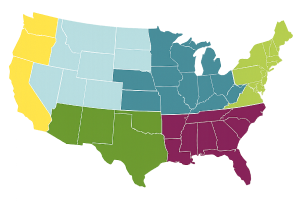Oklahoma Native Plants, State Flower & State Bird
Posted By American Meadows Content Team on Sep 27, 2012 · Revised on Oct 26, 2025

Knowing your location helps us recommend plants that will thrive in your climate, based on your Growing Zone.
Posted By American Meadows Content Team on Sep 27, 2012 · Revised on Oct 26, 2025
Native plants are adaptable, low-maintenance, and beautiful. They are the best choice for habitat-friendly gardens and thriving ecosystems. Find top picks for native plants in your state - and learn about your state bird and state flowers!
Follow Along With More Of Our Guides
Hello native plant enthusiasts! In the list below, you will find popular native plants and wildflower seeds, available from American Meadows, that have a native distribution in your state. You’ll also find information about your state bird, state flower, and state wildflower!
Grow our Native Southwest Wildflower Seed Mix
Showy Goldenrod (Solidago speciosa)
Wrinkleleaf Goldenrod (Solidago rugosa)
Black Eyed Susan (Rudbeckia fulgida)
Black Eyed Susan or Gloriosa Daisy (Rudbeckia hirta)
Giant Black Eyed Susan (Rudbeckia maxima)
Purple Coneflower (Echinacea purpurea)
Pale Purple Coneflower (Echinacea pallida)
Yellow Prairie Coneflower (Ratibida columnifera)
Gray Headed Coneflower (Ratibida pinnata)
Butterfly Weed (Asclepias tuberosa)
Swamp Milkweed (Asclepias incarnata)
Common Milkweed (Asclepias syriaca)
White Tinged Sedge (Carex albicans)
Wild Strawberry (Fragaria virginiana)
Plains Coreopsis (Coreopsis tinctoria)
Lanceleaf Coreopsis (Coreopsis lanceolata)
Wild Bergamot (Monarda fistulosa)
Wild Geranium (Geranium maculatum)
Elderberry (Sambucus canadensis)
Phlox divaricata (Woodland Phlox)
Obedient Plant (Physostegia virginiana)
Red Cardinal Flower (Lobelia cardinalis)
Prairie Blazing Star (Liatris pycnostachya)
Bottlebrush Grass (Elymus hystrix)
Muhly Grass (Muhlenbergia capillaris)
Big Bluestem (Andropogon gerardii)
Little Bluestem (Schizachyrium scoparium)
Northern Sea Oats (Chasmanthium latifolium)
Yellow Prairie Grass (Sorghastrum nutans)
Smooth Blue Aster (Symphyotrichum laeve)
Aromatic Aster (Symphyotrichum oblongifolium)
New England Aster (Symphyotrichum novae-angliae)
Sky Blue Aster (Symphyotrichum oolentangiense)
Ironweed (Vernonia fasciculata)
Common White Yarrow (Achillea millefolium)
Heliopsis (Heliopsis helianthoides)
Purple Prairie Clover (Dalea purpurea)

Scissor-Tailed Flycatcher ~ Muscivora forficata
The courtship ballet of the male Scissor-tailed Flycatcher is unparalleled in the bird kingdom. He climbs to about a hundred feet, plunges down a fourth of the way, zigs up and zags down, all the while sounding a rolling chatter. Finally, he rockets straight up and then falls into two or three spectacular somersaults. For all the painstaking fervor of the courtship rites, Scissor-tails care little for a tidy nest. Frail and sloppily built, their nests are a shallow cup of twigs and grass.
Mistletoe ~ Phoradendron flavescens
Mistletoe is a unique choice among state flowers for two reasons. First, its interest and charm lie in its thick yellowish green leaves and waxy white berries, rather than in its tiny inconspicuous flowers. Second, it is not a garden or cultivated flower but, like its five hundred or more relatives, a parasite, living on the branches of various kinds of trees from which it steals its sustenance. Its name comes from a very old Saxon word meaning “different twig.” It was considered a twig of mysterious power because it remained green in winter, when all the leaves of the tree had fallen. The custom of kissing under a branch of Mistletoe apparently originated among the Druids.
From The Wildflowers of the 50 States U.S. stamps issued July 24, 1992:

